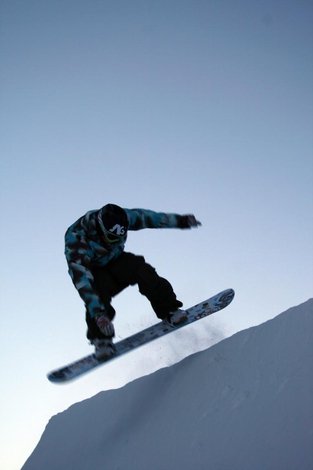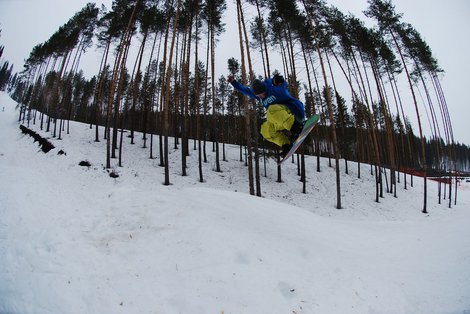Alley-oop
The alley-oop in
snowboarding is a base trick that is essential in halfpipe riding. The first
step will be to ensure that you are creating enough air to pull off the trick.
You are going to want to build up some speed to accomplish this.

As you approach the edge of the halfpipe, keep your board flat. As you exit the
halfpipe and enter the air you can grab the side of your board for support and
to help begin the turn.
Once airborne, begin twisting towards your front shoulder with your upper body
and let your feet follow. Rotate 180 degrees, release the board with your hand
and begin to level out the board in comparison to the halfpipe. Ride back down
the face of the halfpipe.
The alley-oop is commonly combined with many other tricks and it should be the
first trick added to the repertoire when learning how to ride a halfpipe.
Backcountry
Backcountry riding
requires riders to travel off of the beaten path. To ride backcountry, all you
need is untouched snow. This typically means that riders will be forced to find
places that are not maintained or patrolled, which always increases the danger.
It also creates the challenge of getting there. Unless you have access to a
helicopter this means prepare for some hiking.
Backcountry riding is ideal for snowboarder. Snowboards are much more adept at
staying atop the fresh powder than skis. A larger board with the bindings more
set towards the back of the board is better suited for staying on top of the
fresh powder.
Work your way into backcountry riding. Make sure you are comfortable with your
snowboarding skills before attempting to ride backcountry. The first
backcountry runs should be small and close to civilization in case any injuries
occur. Be prepared to get stuck and have a good knowledge of mountain survival
skills. Understand and prepare for the dangers inherent in this style and then
enjoy the freedom of it.
Backside 180
The backside 180 is
a hefty snowboarding maneuver that's guaranteed to impress. It's a good idea to
be familiar with the terrain, so take a practice run or two down the slope, to
familiarize yourself with how the jumps there feel. Once you're comfortable,
make your final approach towards a jump you feel good about, and flatten the
board down to build speed.

An ollie right around the end of the jump can get you that little bit of extra
air, and then start to twist. Ideally, you'll want to twist 180 degrees around
your backside. Keeping your knees bent, and eyes centered between them to watch
your landing point, you can come down softly in the snow after the jump. Voila!
That's how you serve up a fresh backside!
A "backside" spin just means that you turned your backside downhill
first, so a frontside 180 just goes the opposite way. Now you've just doubled
your arsenal of learned snowboard tricks, get out there and tear it up!
big air
In snowboarding Big
Air is a type of competition in which the athlete uses a long slope to achieve
the highest possible speed in order to launch themselves from the end of a
ramp. In this competition the entrant attempts to attain the highest possible
arc combined with the longest distance.
While airborne, sometimes, the boarder will attempt to boost his or her score
by doing tricks. The tricks can range from twists, flips, back flips, or any
combination of a large assortment of maneuvers that are still being developed
by competing pro's. The judges usually score the events on a 0-100 point basis.
Most events require that the skier do tricks, but some don't, almost always
though, the competitor must land safely to complete the run.

With the growing popularity there has been an upsurge in the world class
events, recent scheduling has even managed to get an event in Seoul, South
Korea, marking a huge stride for the sport in the world community. Smaller
local events though, are always being added to the circuits, with the promise
of smaller prizes, but still are very popular events.

Comments